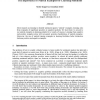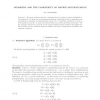244 search results - page 4 / 49 » On the geometry of polar varieties |
DAC
2003
ACM
14 years 8 months ago
2003
ACM
As CMOS technology continues its monotonic shrink, computing with quantum dots remains a goal in nanotechnology research. Quantum-dot cellular automata (QCA) is a paradigm for low...
CI
2006
13 years 7 months ago
2006
Most research on learning to identify sentiment ignores "neutral" examples, learning only from examples of significant (positive or negative) polarity. We show that it i...
CORR
2007
Springer
13 years 7 months ago
2007
Springer
We survey results in algebraic complexity theory, focusing on matrix multiplication. Our goals are (i.) to show how open questions in algebraic complexity theory are naturally pose...
DGCI
2009
Springer
13 years 8 months ago
2009
Springer
To find corresponding points in different poses of the same articulated shape, a non rigid coordinate system is used. Each pixel of each shape is identified by a pair of distinct c...
SIAMSC
2011
13 years 2 months ago
2011
In order to compute polarization energy of biomolecules, we describe a boundary element approach to solving the linearized Poisson–Boltzmann equation. Our approach combines sever...


